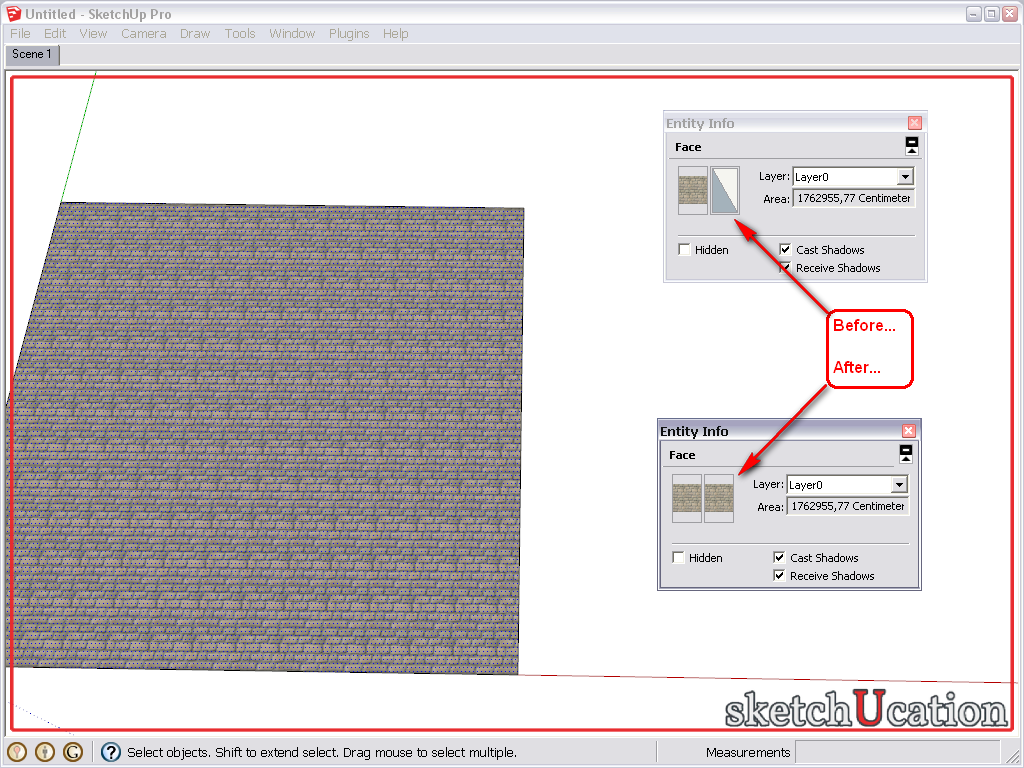Applying a Material to Both Faces
-
Is there ruby script that will make both faces the same material allowing the user to choose the white or blue face as the basis? I run into problems when I run a rendering and one of the faces is reversed in the conversion process.
-
It would be better to practice good modeling skills and correct the face orientation before applying materials. In at least some renderers, exposed back faces will render as black. As in there's nothing there. Even if the material is applied to both faces, if the face toward the camera is a back face, it won't show.
-
I work on large architectural models that are used by people throughout our office with all different skill levels. If I was the only one to touch the model this would not be a problem. I also use lighting materials that when inadvertently applied to a back surface can really mess up a rendering. Thanks for the advice, but I still would like to find a ruby script that can quickly match a back face to its front face.
-
@dave r said:
It would be better to practice good modeling skills and correct the face orientation before applying materials. In at least some renderers, exposed back faces will render as black. As in there's nothing there. Even if the material is applied to both faces, if the face toward the camera is a back face, it won't show.
I would have to agree with Dave, I used to get this all the time and found the best practice is just to make sure the model is clean from the start.
-
Matching the material on a back face to that on a front face won't change the fact that it is a back face.
Why not take the opportunity to teach the others in the office how to make clean models? It isn't difficult to make clean models, after all.
-
Liam & Dave,
I'm in complete agreement with both of you and I appreciate the advice, but this does not solve my immediate problem. I often get handed models that are so messed up it would take days to go back and fix all of the problems. I also receive models from clients all over the U.S. with deadlines that do not allow for me to go back and make manual corrections. I have to take what is given to me and run with it. As a tool, the afore mentioned script would be very helpful. I would still like to find this script if anyone is aware of one.
-
-
@tahota said:
Liam & Dave,
I'm in complete agreement with both of you and I appreciate the advice, but this does not solve my immediate problem. I often get handed models that are so messed up it would take days to go back and fix all of the problems. I also receive models from clients all over the U.S. with deadlines that do not allow for me to go back and make manual corrections. I have to take what is given to me and run with it. As a tool, the afore mentioned script would be very helpful. I would still like to find this script if anyone is aware of one.
Ahh ok well thats difficult. I did a job where I got some models from Nasa and had to re-model them with much more detail. Half of them had backwards faces... weeks it was before we had them all sorted!
-
Note that if you plan to render you might have to fix the faces after all. SketchUp is in general more forgiving about front/back faces - but render engine relies on correct face direction much more. If you see strange artifacts the first thing you want to check is your normals.
And

 for ThruPaint!
for ThruPaint! -
While I am in complete agreement with all the suggestions (keep model clean and consistent), I understand that there are cases of course, when one needs to quit the "rules". So ThomThoms UV toolkit will do the job for you - even keeping all the UV co-ordintes.

Also, there are a bunch of "reverse faces" plugins that will do the same. FrontFace is by Tomasz and while it is reversing the faces (even through group and component wrappers), it copies the material (until then applied to the back face) onto the front face - also keeping UV's.
Advertisement







